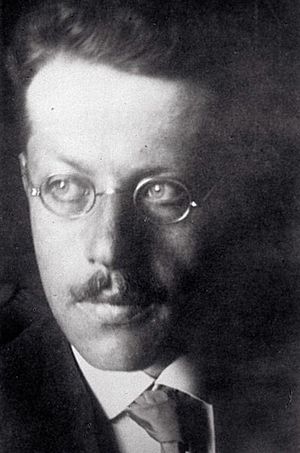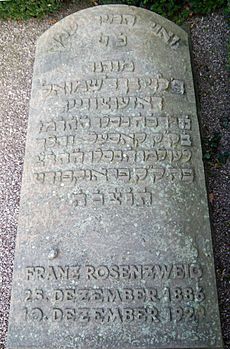Franz Rosenzweig facts for kids
Quick facts for kids
Franz Rosenzweig
|
|
|---|---|
 |
|
| Born | 25 December 1886 |
| Died | 10 December 1929 (aged 42) |
| Era | 20th-century philosophy |
| Region | Western philosophy |
| School | Continental philosophy Existentialism |
|
Main interests
|
Theology, philosophy, German idealism, philosophy of religion |
|
Notable ideas
|
Star of Redemption |
|
Influences
|
|
|
Influenced
|
|
Franz Rosenzweig (born December 25, 1886 – died December 10, 1929) was an important German philosopher, theologian, and translator. He is known for his ideas about how God, humanity, and the world are connected.
Contents
Early Life and Studies
Franz Rosenzweig was born in Kassel, Germany. His family was wealthy and Jewish, but they didn't follow all Jewish traditions strictly. His father owned a factory and was part of the city council.
When Franz was about 11, he became interested in traditional Judaism through his granduncle. He asked for Hebrew lessons, but he didn't learn about the Sabbath (the day of rest) until he was in college.
He first studied medicine at universities in Göttingen, Munich, and Freiburg. In 1907, he changed his focus to history and philosophy in Freiburg and Berlin.
A Change of Heart
For a time, Rosenzweig thought about becoming a Christian. He wanted to understand the Christian faith deeply, so he decided to first live as a very observant Jew. He attended Yom Kippur services (a very important Jewish holiday) at a small synagogue in Berlin. This experience changed his life. He decided to remain Jewish and became a baal teshuva, which means someone who returns to a more traditional Jewish way of life.
In 1913, he began to focus on Jewish philosophy. He studied with Hermann Cohen, a famous philosopher, and they became close friends. While writing his doctoral paper about the philosopher Georg Wilhelm Friedrich Hegel, Rosenzweig started to disagree with some common philosophical ideas. He wanted a philosophy that focused on real human life, not just abstract thoughts.
Later, Rosenzweig found an old paper that seemed to be written by Hegel. He called it "The Oldest Systematic Program of German Idealism." This discovery was very important for understanding Hegel's early ideas.
Main Ideas and Work
The Star of Redemption
Rosenzweig's most famous book is The Star of Redemption, published in 1921. In this book, he describes how God, humanity, and the world are connected. He explains these connections through three main ideas: creation, revelation, and redemption.
He believed that real human life is more important than abstract ideas. For Rosenzweig, revelation (when God shows himself to people) happens in our everyday lives, not just in big, grand ways. He taught that when we love God, we are called to return to the world and make it better. This is what he meant by redemption.
Working with Martin Buber
Rosenzweig became good friends with another important Jewish scholar, Martin Buber. They worked together on a special project: translating the Tanakh (the Hebrew Bible) from Hebrew into German. Their translation was unique and influenced many other Bible translations in different languages. Their ideas about how to translate texts are still studied today.
Starting a New School
Rosenzweig wasn't happy with how universities taught things. He felt they were too impersonal. So, in 1920, he started his own school in Frankfurt called the House of Jewish Learning. This school focused on open discussions and learning together, rather than just collecting facts.
Many famous Jewish thinkers were part of the Lehrhaus, including Gershom Scholem, who studied Kabbalah (Jewish mysticism). The school stayed open until 1930 and was later reopened by Martin Buber in 1933.
Later Life and Legacy
Towards the end of his life, Rosenzweig became very ill with a muscle disease called amyotrophic lateral sclerosis (ALS). This disease made it very hard for him to move and speak. He had to communicate with his wife, Edith, by blinking his eyes or by having her say letters of the alphabet until he signaled the right one.
He was working on his last thoughts using this difficult method when he passed away on December 10, 1929, in Frankfurt. He left his last sentence unfinished.
Franz Rosenzweig was buried on December 12, 1929. Martin Buber read a psalm at his funeral. After his death, Rosenzweig's son, Rafael, moved to Palestine in 1939. Rosenzweig's large library of books, about 3,000 volumes, was meant to follow him. However, the ship carrying the books was redirected during World War II. Today, his library is kept in the National Library of Tunisia.
See also
 In Spanish: Franz Rosenzweig para niños
In Spanish: Franz Rosenzweig para niños
- Interfaith dialogue
- André Neher



